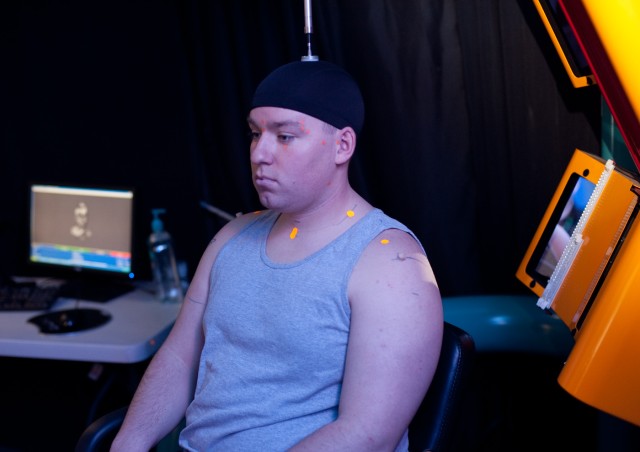CAMP ATTERBURY, Ind., March 25, 2011 -- Natick Soldier Research, Development and Engineering Center is currently conducting an Army-wide study of human physiology, called the U.S. Army Anthropometric Survey, or ANSUR II.
Anthropometry is the study of the measurements and proportions of the human body.
During World War II, 40 percent of recruits rejected for military service were due to poor nutrition according to Congressional testimony in 1945. As a result, the recruits that made it into the military were on average an inch and a half shorter than today's recruits, according to a 2010 study.
Improved nutrition changed the physical characteristics of Americans and as a result, people today are physically larger than in the 1940s. The implications of this trend for the Army extend to the systems that today's Soldiers use.
The current data set, created in 1988, for the design of systems used by Soldiers has not completely kept up with the changes to the physiology of the American Soldier. During Operation Iraqi Freedom, this resulted in a shortfall of equipment and uniforms on the larger side, according to Cynthia Blackwell, program director for ANSUR II.
The survey team is currently gathering measurements from about 750 Soldiers at Camp Atterbury Joint Maneuver Training Center, Ind., before going to Fort Drum, N.Y., said Blackwell.
Overall, more than 12,000 Soldiers, including 1,000 aviators, will be scanned from U.S. Army Forces Command, Training and Doctrine Command, National Guard Bureau, and First U.S. Army de-mobilization sites.
"We're updating to reflect the total Army, including the National Guard and Reserve because that is most of our force, and we have to accommodate them," said Blackwell. The 1988 survey did not include National Guard or Reserve Soldiers, she added.
The survey includes 94 measurements of the body as well as three 3-D scans. The scans are of the whole body, the head and face and a foot. While the measurements are point to point, the 3-D scans are able to map the contours of the human body, creating a more accurate picture of body composition that will aid in the design of systems for Soldiers in the future.
"It is an engineering database. Its purpose is to help design digital human models for computer-aided design and other simulators as well as the development of models for individual equipment and clothing; everything from socks to body armor to headgear. There are broad applications for this data across all the engineering and design disciplines for the Army and Army gear," said Blackwell.
The data gathered will also find application in the design of vehicle interior spaces. This extends from aircraft to ground vehicles to ensure the people operating the systems will be able to do so, and that entrance and egress points will be large enough to accommodate Soldiers while wearing their equipment, said Blackwell.
The data will also be used in the development of future technologies such as improved body armor that will be created with the contours of the human form in mind, said Blackwell.
Soldiers selected for the survey represent a sample of the Army population, said Joseph Parham, the government field supervisor for ANSUR II.
"We are trying to get a good sample of all age groups and races in the Army so that when the database is compiled at the end, it represents the Army and is valid," said Parham.
The targets for the sample were developed by looking at the demographics of the Army as a whole, with specific numbers based on gender, active, Reserve or National Guard status and minority groups, said Parham.
"Minority groups are being oversampled due to the trend that more minorities are joining the Army and we expect that trend to continue," said Parham. "By oversampling these minorities, we can ensure that the database will continue to be valid in the future."
Considering the lifespan of the original survey the data gathered will have a significant impact on the development of future Army systems.
Camp Atterbury was selected as a location for the survey due to a large number of National Guard and Reserve Soldiers at one location, said Capt. Matthew McGowen, Installation Support Unit commander at Camp Atterbury.
"The ANSUR II team came to Camp Atterbury to get a sampling of National Guard and Reserve warfighters. National Guard and Reserve Soldiers are an integral part of the U.S. Army and the ANSUR II team being at Camp Atterbury conducting part of their survey is a testament to our part in the operational force structure," said McGowen.
"This is a valuable program that will assist the Army in projecting 'how much and of what size' to budget for uniforms and equipment," said McGowen. "This program is designed to reduce costs and better equip our Soldiers."
Related Links:
Researchers begin Army-wide anthropometric survey
Benning female Soldiers test new Women's Army Combat Uniform
U.S. Army Natick Soldier Systems Center
Army.mil: Science and Technology News


Social Sharing